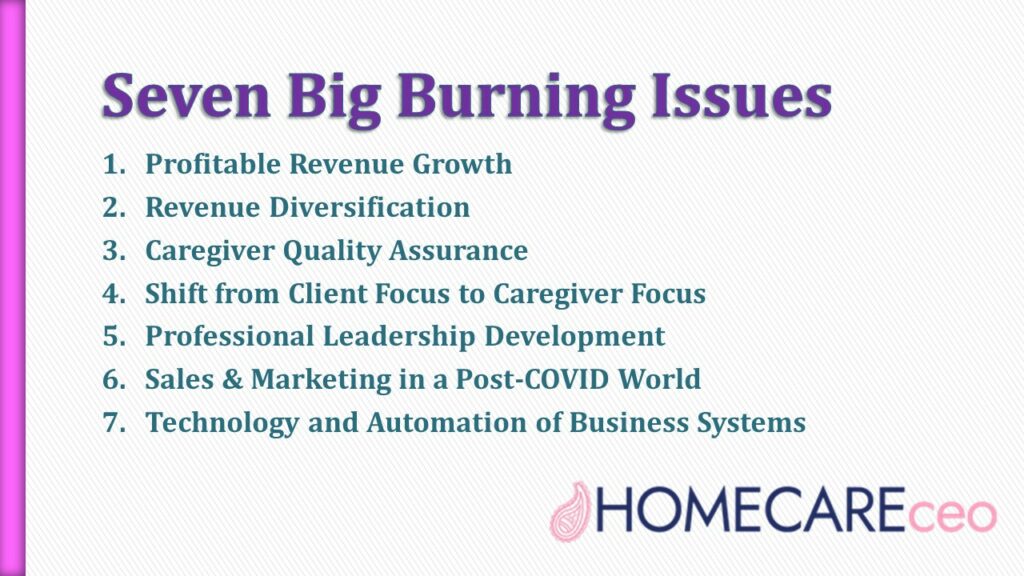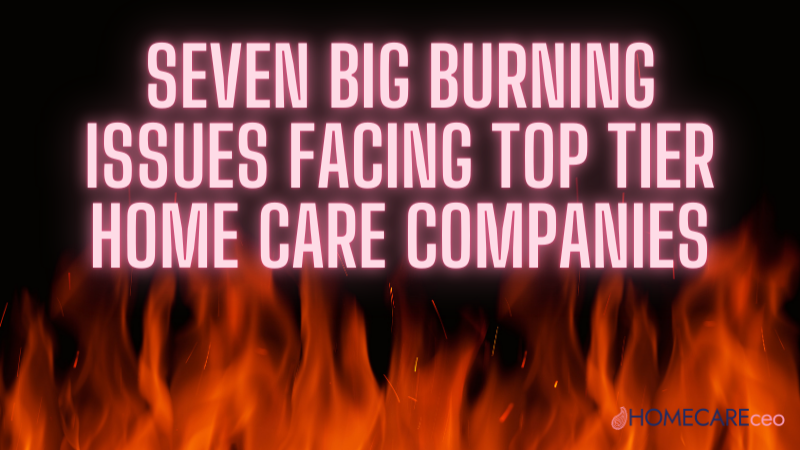By Stephen Tweed
As a home care company owner or leader, what are the biggest issues you are facing that are getting in the way of growing your business?
How do you go about addressing those big issues?
Who do you go to for help in working through the challenges?
Every home care company leader faces challenges that get in the way of fulfilling your vision. How you deal with these challenges often determines your success.
During two weeks in February, 2023, all five of our Home Care CEO Mastermind Groups met in person in Southwest Florida for a series of two-day meetings. One of the most valuable things in our live meetings in our “Big Burning Issues Agenda.” For a whole day, we divide up the time and give each member company the opportunity to share one big burning issue, how that issue is affecting their business, and what they are doing the address the issue. Then the member asks the rest of the group for help in solving the issue or meeting the challenge. The feedback from this insight-packed day is always amazing.
Seven Big Burning Issues from Top Tier Mastermind Groups

While all of our members dug into meaningful issues, I wanted to summarize seven specific issues that came our of our Top 5% and Top 7% groups. The members of these groups are significantly larger in annual revenue than the members of our other groups, and their issues are somewhat different. And, how they address these issues may be quite different.
Here’s a summary of the seven biggest issues facing our biggest companies.
1. Profitable Revenue Growth
Most members of home care companies in our groups had relatively low growth or no growth in revenue from 2020 to 2021. Many said that 2021 was actually a more difficult year than the COVID year of 2020. While most of our members showed revenue growth in 2022 over 2021, that growth was much lower than they had projected, and margins continued to be squeezed. Our largest companies had average annual growth of 7.81%, and the increased their net income from operations by 9.35%
The two big barriers to growth in 2022 were the caregiver shortage, and the challenge resetting sales and marketing processes in a post-COVID world.
2. Revenue Diversification as a Growth Strategy
Over the ten years that our Home Care CEO Mastermind Groups have been operating, the vast majority of our members have focused on private pay home care. This has changed in the past few years as more of our members have focused on other payer sources such as Medicaid Waiver, Veterans Administration, and Long-Term Care Insurance. Several members acquired other home care companies that brought with them a book of Medicaid business. We also have about half of the members of our Top 5% Group who generate a majority of their revenue serving Medicaid Waiver beneficiaries.
These facts have raised a significant question for several of our members; should we explore growing by diversifying our company into other revenue streams and payer sources?
3. Caregiver Quality Assurance
Everyone in home care is faced with the Caregiver Recruiting and Retention Crisis. I wrote about it in detail in my 2017 book, Conquering the Crisis: Proven Solutions for Caregiver Recruiting and Retention.
Most of our members have put in place new processes for recruiting and retention and are able to attract more new caregivers. However, the demand for services far outweighs the availability, so nearly everyone is turning down some new clients.
The result is a major shift in focus, with many member companies working diligently on their company culture, on professional leadership development, and on caregiver retention.
4. How to Shift from Client Focus to Caregiver Focus
Many years ago, I visited a major grocery store in Connecticut that had become famous for their business growth through exceptional customer service. Outside the main door was a large stone with an inscription carved on it:
Rule #1: The Customer is always right!
Rule #2: If the customer is ever not right, go back and read rule number 1.
Well, the home care industry in 2023 is turning that mantra on it’s ear. Many owners of top tier companies have made a major strategic decision to shift their culture from “Customer First” to “Caregiver First”. For many seasoned entrepreneurs, the idea of saying “NO” to a customer so you can say “Yes” to a caregiver is most challenging. Yet we are seeing these companies prosper while others are struggling. The premise is … “Take care of your caregivers, and they will take care of your clients.”
5. Professional Leadership Development and Company Culture
Following up on issue number 4, many of our top tier members are investing in developing leaders in their companies, and in crafting a new company culture. These are both long term commitments that take a significant investment in time, talent, and treasure. This is one a quick fix, which is why most owners of smaller companies are not ready to make this type of investment. Yet the top tier companies are seeing measurable improvement in their businesses as a result of these efforts.
6. Sales & Marketing in a Post-COVID World
Most home care companies had their sales and marketing processes disrupted or destroyed by the COVID Pandemic. Getting in to have a personal meeting with a high potential referral source was nearly impossible in 2020 and 2021. While referral sources are more accessible in 2022 and 2023, many companies pulled back their sales and marketing efforts because the did not have enough caregiver to take on new client. They didn’t want to disappoint referral sources by making effective sales calls, and then having to decline the referral because they couldn’t staff the case.
This is beginning to change as more large companies are refocusing their marketing process on defining their “ideal clients”, and finding new ways to serve those client who need high hours per week and long lengths of stay.
One of the interesting data points from our own internal benchmarking study is that our largest members, and our most profitable members, have the highest average hours per client per week, and the longest lengths of stay. Simultaneously, we see that these same members have the highest average hours worked per week for caregivers and have reduced their turnover dramatically. This has led to some great new insights into finding and keeping caregivers who really want to work. (See Caregiver Quality, above.)
7. Applying Technology to automate Home Care Business Systems
Nearly every home care company owner in our mastermind groups is focused on how to spend more time working ON their business, and less time working IN their business. These leaders are exploring ways to systematize their home care business, and they are looking for ways to apply technology to automate their business systems.
One big source of frustration for top tier leaders in home care is that number of online software systems that don’t talk to each other. That means growing companies may need to use a number of different technologies to get the automated systems they want.
Yet we are finding solutions in working with leading software companies who are moving away from “Scheduling software” and toward “Home Care Operating Systems.” While there is no one software that does everything you need to do to automate your home care company, they are making great progress.
Join Other Masters Level Home Care Companies Discussing These Burning Issues
At the Home Care CEO Forum, we are working with our Resource Partners, AxisCare and Home Care Pulse, to explore ways to address these seven big burning issues. We are hosting a three-part web conference presented specifically for “Masters Level” home care company. HCP defines Masters Level as those companies generating $5 million or more in annual revenue.
If you fit this category, we invite you to participate in this interactive conference and hear from some thought leaders in our industry. Take a few minutes right now to get more information on this program, and then register to attend.


